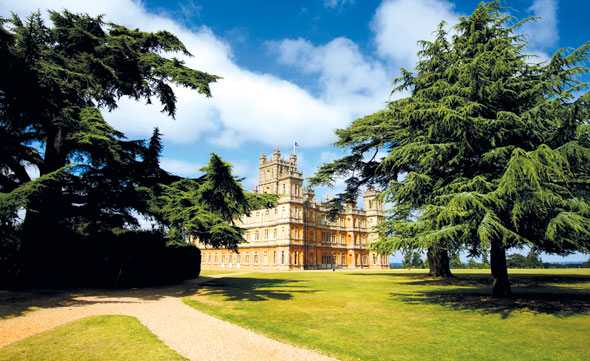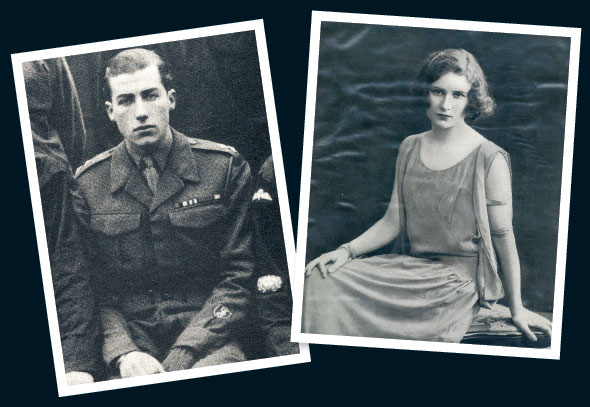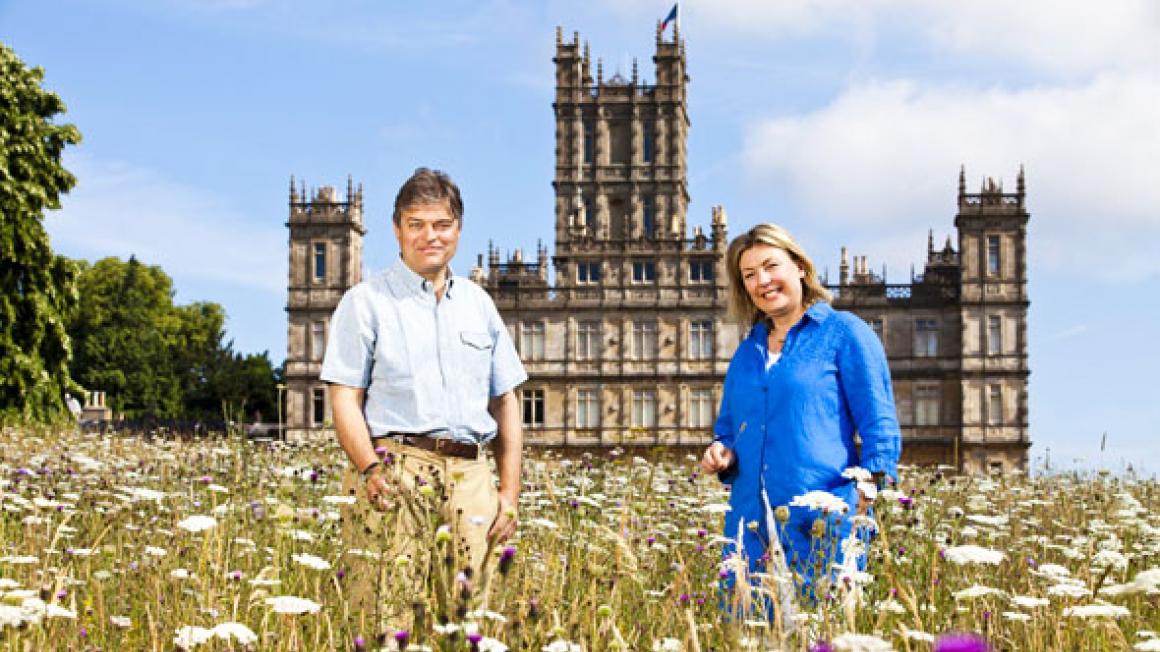‘The ghosts?The dogs are very sensitive to them…’
‘Our Labradors [Percy and his daughter, Bella] are very sensitive to them,’ she laughs. ‘A few years ago, I saw one particular ghost, a footman, while I was with my young son Edward. The older dog was on the other side of very heavy doors, and he went ballistic, barking crazily. He was as concerned and worried as I was.’
The countess – an auditor with accountancy firm Coopers & Lybrand before she married the 8th Earl, Geordie – talks openly and engagingly about the supernatural residents of Highclere. Intriguingly, she may even have identified this one.
‘There was a footman here during the Victorian period, who committed suicide not far from where I’d seen him. He’d been having an affair with a nursemaid, who became pregnant. Sadly, their baby died, probably of cot death, and he killed himself.
‘So there I was, a young countess with a newborn baby, and he came out. I was walking faster, and he was following, and then we decided to wish him all the best and send him on his way. Sometimes people get trapped – I just try to respect the people who’ve been here before.’
 Highclere Castle
Highclere CastleI attempt to dig deeper, but it seems the exact location of the sighting will have to remain a secret. ‘I can’t tell you that,’ she chuckles. ‘None of the staff would ever go there again.’
So have the ghosts appeared to her husband, too? ‘I haven’t really seen them,’ he admits. ‘But I’m not sceptical. I just think that some people are more in tune with meeting them, seeing them or feeling them than others.’
Highclere, the seat of the Carnarvon family since 1679 and the setting for Julian Fellowes’s hugely successful television drama Downton Abbey, is full of stories. And many are stored in cardboard boxes in the castle’s archive rooms.
These boxes, and the dramas they contain, are a labour of love for the affable and very likeable countess, who loves nothing more than rummaging through Highclere’s history – often in forensic detail.
Her new book, for example, tells the story of dazzling Anglo- American Catherine Wendell – coincidentally, like the Duchess of Cambridge, she also had a sister called Philippa – who married Lord Porchester, otherwise known as Porchey. Porchey was the son of the 5th Earl of Carnarvon, but inherited the title young when his father, who had opened Tutankhamun’s tomb alongside Howard Carter just weeks earlier, died suddenly of blood poisoning, aged 56.

The couple was unexpectedly thrust into the limelight, and took on the daunting task of securing the estate’s future at a time of great economic uncertainty. With half a million owed in death duties, Highclere was on a knife edge and many of its treasures, including the family’s exquisite pearl necklace, quickly had to be sold in a vast Christie’s auction.
The sale returned a degree of financial security to Highclere, but Catherine’s marriage was soon under pressure as Porchey developed a penchant for carousing, boozing and philandering with a procession of fast women.
‘Porchey was of a generation that was just so amazed that they had got through the horrors of the first war,’ the earl explains. ‘It was a miracle to survive. Many of his friends were dead. There was this desire to pursue excitement after all of the misery.’
Eventually, however, he fell in love with Tanis Montagu, ex-wife of the Earl of Sandwich, and asked Catherine for a divorce. In 1936, after 14 years as Lady Carnarvon, Catherine was forced to leave Highclere for a new, uncertain life in London.
It sounds rather like a plot from Downton Abbey. But then in homes such as these the facts are often even livelier than the fiction. ‘After doing my research, I am amazed we’re still here,’ says the countess. ‘But that’s at the heart of the Downton story, too, isn’t it? Will there be an heir? Will the house survive? Will there be enough money?’
Partly thanks to Downton – the earl tells me that visitor numbers have probably increased four-fold thanks to the show – Highclere is enjoying another period of financial security. But running one of Britain’s finest estates, which includes 1,000 acres of parkland and 5,000 acres of farmland, requires vast amounts of work and money, and comes with huge responsibility. Just restoring the Temple of Diana, in the castle grounds, for example, cost £500,000, ‘and that’s not even an income-producing part of the estate,’ says the earl.
 The Earl of Carnarvon with Porchey's restored Rolls-Royce
The Earl of Carnarvon with Porchey's restored Rolls-RoyceCurrently, a debate is raging about succession. The law was altered recently to allow a first-born daughter of the Duke and Duchess of Cambridge to become Queen. The changes, however, do not yet apply to the nobility and daughters usually can’t inherit their father’s titles and estates.
‘Well, there’s obviously a reason for these things, which was to keep the place intact with the same name attached to it,’ says the earl. ‘If you go further down that road, you are going to be heading towards the Napoleonic Code, which would break up all the great British places and that would be the end of them. It would mean selling them all, which probably wouldn’t be the best idea.
‘The title does die or it slips to a cousin,’ adds the countess, ‘but that’s as it is. There’s simply no point worrying about it.
‘In today’s world, these houses are not personal assets anyway. This is not our personal asset. It is our personal passion and our home for the time being, but it’s a shared treasure. The world has moved a long way since the 1920s and 1930s when Highclere was the private residence and amusement of Catherine and Porchey.
‘We can only pass it on in as good nick as possible and then it’s up to the next generation who will be confronted with different obligations and challenges.
 Henry Porchester and Catherine Wendell
Henry Porchester and Catherine Wendell‘These houses were designed to be shared,’ says the countess. ‘Because of Downton, people can now come and share the house and see where Maggie Smith sat and that’s brilliant. It’s an odd mixture of reality and fiction. The whole thing is muddled together, which is rather fun.’
But how big a part do the Carnarvons play in the creation of Downton Abbey? They are, after all, close friends with Julian Fellowes. ‘I don’t want to step on Julian’s toes,’ says the countess. ‘The press report things that are obviously untrue and we are both kind of used to it. We have jokes, so it’s just about trying to maintain a friendship over something that has sprung into rather a big business.’
And her favourite character? ‘The house, of course.’
Indeed, if there’s one message that comes across loud and clear from the countess and her books, it is that Highclere has always been the main protagonist in this family’s extraordinary story. Everyone else, from Catherine and Porchey to the ghosts, are merely colourful extras.
Lady Catherine And The Real Downton Abbey, by the Countess of Carnarvon, is published by Hodder & Stoughton, priced £20.



